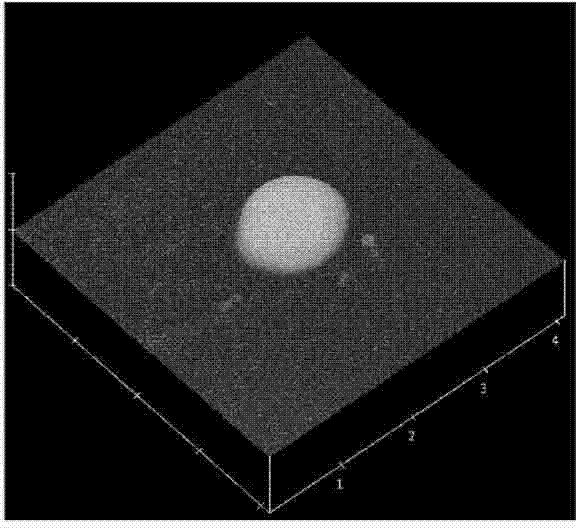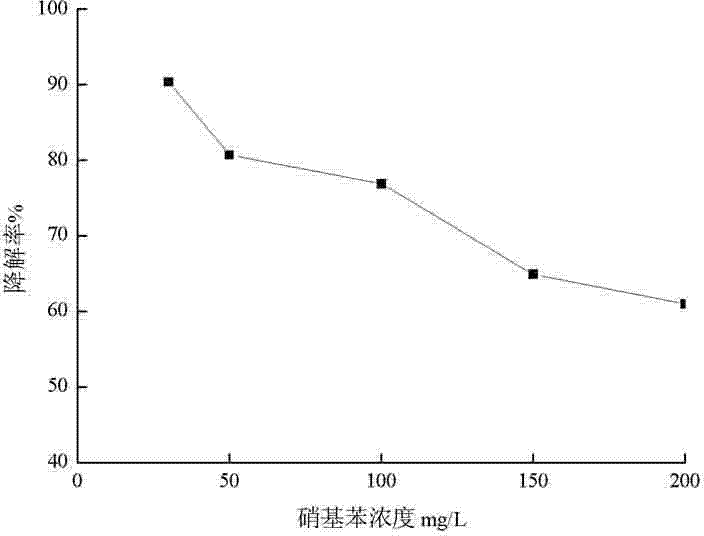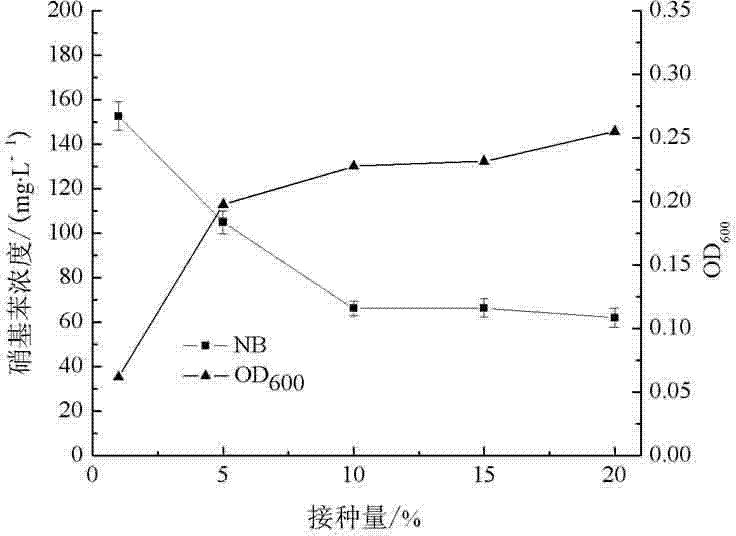Method for degrading nitrobenzene in waste water
A technology for nitrobenzene and waste water, applied in the field of nitrobenzene, can solve problems such as poor metabolism of nitrobenzene, and achieve the effects of low cost, guaranteed degradation rate, and good degradation
- Summary
- Abstract
- Description
- Claims
- Application Information
AI Technical Summary
Problems solved by technology
Method used
Image
Examples
Embodiment 1
[0023] Inoculate the bacterial suspension of strain cc-2 in the logarithmic growth phase at 10% (v / v) in the nitrobenzene inorganic salt medium (inorganic The main formula of the salt medium is: 3.8g of dipotassium hydrogen phosphate, 1g of potassium dihydrogen phosphate, 1g of sodium chloride, 0.1g of ammonium chloride, 0.2g of magnesium sulfate, 2g of glucose, made into 1000ml with distilled water), at 15℃ , pH = 7, 140r / min conditions shaking culture for 48 hours. Utilize gas chromatography to measure the nitrobenzene degradation rate of bacterial strain 48h, degradation result is as follows figure 2 .
[0024] Such as figure 2 As shown, the degradation rate of strain p-nitrobenzene decreases with the increase of the initial concentration of nitrobenzene, and the degradation rate is 80.64% at 50 mg / L, and drops to 60.94% at 200 mg / L
Embodiment 2
[0026] OD 600 The strain cc-2 bacteria suspension of =2 is inoculated to the nitrobenzene inorganic salt medium (inorganic salt medium) with a nitrobenzene concentration of 200mg / L by 1%, 5%, 10%, 15% and 20% volume fraction The main formula is: 3.8g of dipotassium hydrogen phosphate, 1g of potassium dihydrogen phosphate, 1g of sodium chloride, 0.1g of ammonium chloride, 0.2g of magnesium sulfate, 2g of glucose, made into 1000ml with distilled water), at 15℃, pH = 7. Culture with shaking at 140r / min for 48 hours. Utilize gas chromatography to measure the nitrobenzene degradation rate of bacterial strain 48h, utilize photoelectric turbidimetry to measure the growth situation of bacterial strain simultaneously, degradation result is as follows image 3 .
[0027] Such as image 3 As shown, with the increase of the inoculum size, the strain OD 600 increased, the growth of the strain was good, and the degradation rate of nitrobenzene also increased, but when the inoculation am...
Embodiment 3
[0029] Inoculate the bacterial suspension of strain cc-2 in the logarithmic growth phase at 10% (v) to nitrobenzene with a pH value of 4, 5, 6, 7, 8 and 9 and a nitrobenzene concentration of 200mg / L Inorganic salt medium (the main formula of inorganic salt medium is: 3.8g of dipotassium hydrogen phosphate, 1g of potassium dihydrogen phosphate, 1g of sodium chloride, 0.1g of ammonium chloride, 0.2g of magnesium sulfate, 2g of glucose, made into 1000ml with distilled water ), cultured with shaking at 15°C and 140r / min for 48h. Utilize gas chromatography to measure the nitrobenzene degradation rate of bacterial strain 48h, utilize photoelectric turbidimetry to measure the growth situation of bacterial strain simultaneously, degradation result is as follows Figure 4 .
[0030] Such as Figure 4 As shown, when the pH value increased from 4 to 7, the strain OD 600 and degradation rate were significantly increased, and when the pH was greater than 7, the strain was inhibited, and...
PUM
 Login to View More
Login to View More Abstract
Description
Claims
Application Information
 Login to View More
Login to View More - R&D
- Intellectual Property
- Life Sciences
- Materials
- Tech Scout
- Unparalleled Data Quality
- Higher Quality Content
- 60% Fewer Hallucinations
Browse by: Latest US Patents, China's latest patents, Technical Efficacy Thesaurus, Application Domain, Technology Topic, Popular Technical Reports.
© 2025 PatSnap. All rights reserved.Legal|Privacy policy|Modern Slavery Act Transparency Statement|Sitemap|About US| Contact US: help@patsnap.com



